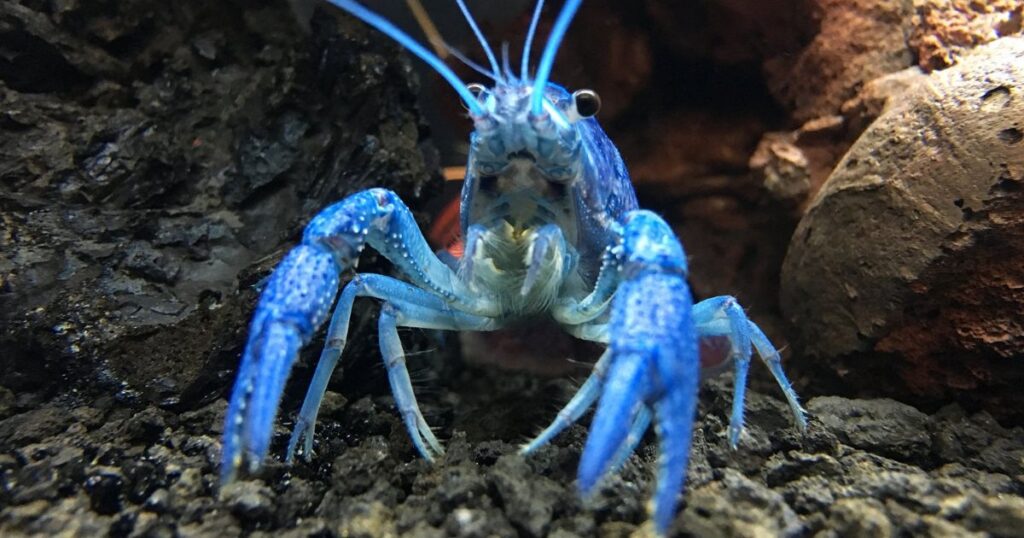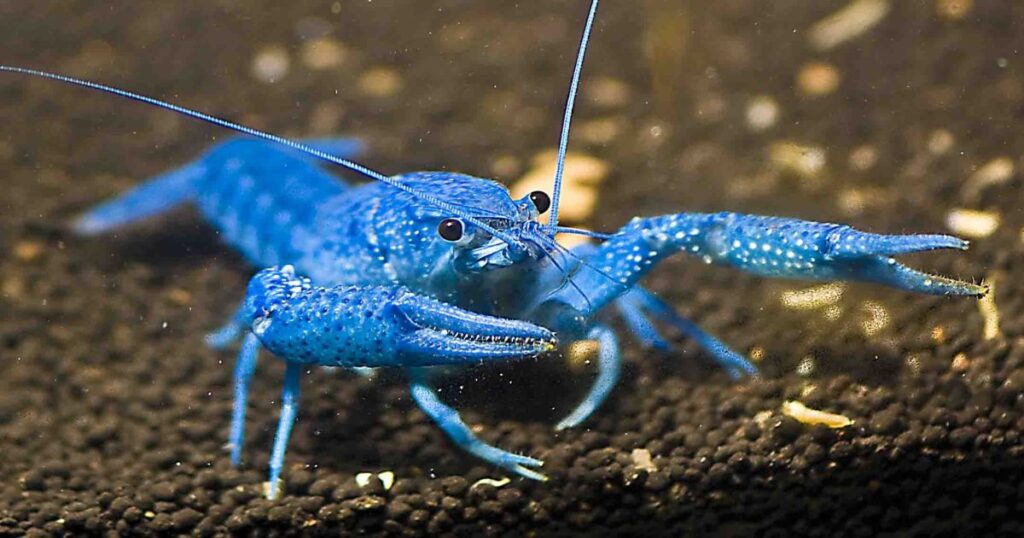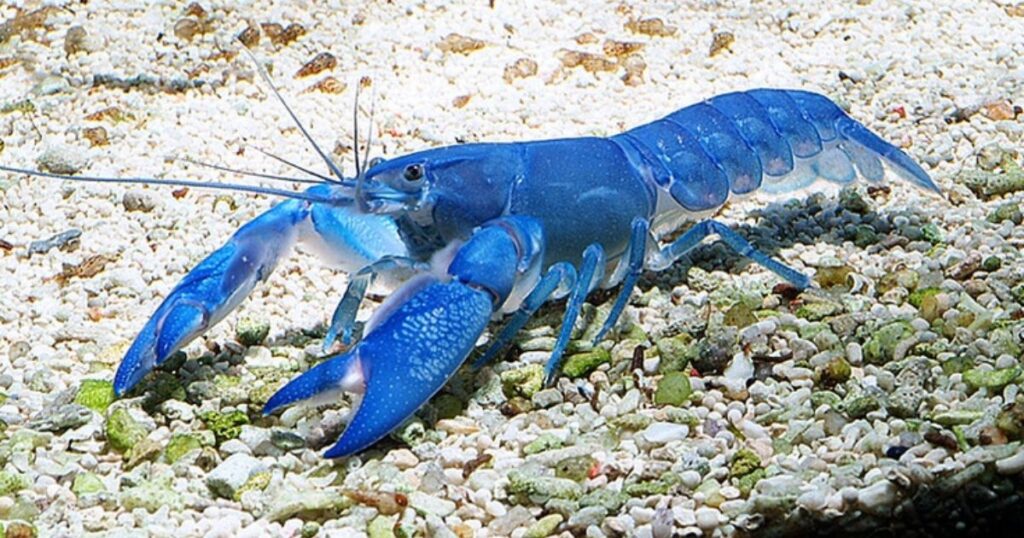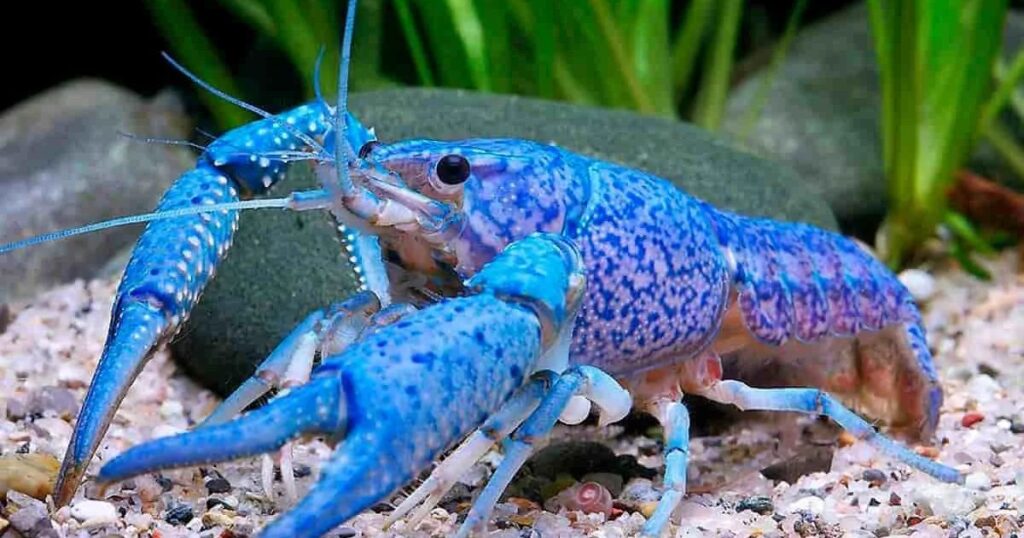Crayfish, often referred to as freshwater lobsters, are captivating crustaceans that make unique and entertaining additions to aquariums.
These fascinating creatures have captured the hearts of aquarium enthusiasts worldwide with their intriguing behaviors and vibrant colors, like the stunning electric blue crayfish.
To ensure their well-being and fully appreciate their charm, proper crayfish care is essential. In this comprehensive guide, we’ll delve into the key aspects of setting up a thriving crayfish habitat and understanding their dietary needs.
Blue Crayfish Species Profile

In the Wild
These neat little crustaceans are originally from the waters of the Florida peninsula. In their natural environment, their color can range from brown to a dull, bluish-buff shade.
They are scavengers that will eat pretty much anything they can find: plant matter, dead fish and other invertebrates, insects and their larvae, fish eggs, worms, and so on. These crayfish are also cannibals that will kill and eat other crayfish if given the chance.
In the Aquarium
Aquarium enthusiasts have selectively bred this species to produce crayfish with a bright, cobalt blue color. Blue crayfish live their lives along the bottom of the tank, crawling on the substrate. They are quite aggressive creatures.
They have been known to suddenly attack and grab unsuspecting fish that get too close to them. Blue crayfish should not be kept in any kind of community tank.
They will kill and eat any tank mates they get the opportunity to. My late husband had a crayfish that speared his 10-inch (25-centimeter) blue-eyed pleco through the head, killing it instantly.
A crayfish might seem to peacefully coexist with other tank inhabitants for a while, but eventually, they will see an opportunity and strike.
Read More : Koi Betta Fish: The Ultimate Care Guide
How to Set Up a Blue Crayfish Tank
Tank Size
Keep a single blue crayfish in at least a 30-gallon (113-liter) tank. These crayfish need a tank with a large surface area since they live and move around on the bottom. They require a big space to walk and multiple hiding spots to choose from. Longer tanks are better than taller ones.
Tank Lid
Blue crayfish are great escape artists, so it’s best to have a tight-fitting lid to prevent them from wandering around your living room. Crayfish are very good at climbing and can survive temporarily out of water. They often climb on decorations or equipment as a way to escape.
Filtration
Surprisingly, crayfish will actually eat sponge filters. Many species will graze on the surface of a sponge filter to eat the gunk that collects and grows there.
But crayfish take it further and eat the sponge itself, which is pretty crazy. You can try using a sponge filter, but if you notice it getting rounded off at the edges, you might want to switch to a different type of filter.
For a blue crayfish tank, I would recommend a good hang-on-the-back filter. The bioload will be very small, so a canister filter might be too much in this case.
Habitat Setup

Creating the right environment is crucial for the health and happiness of your crayfish. These crustaceans have specific requirements that must be met to thrive in captivity.
One of the most important factors is the tank size. A 20-gallon aquarium is generally suitable for housing one or two crayfish comfortably. Larger tanks may be necessary if you plan to keep multiple crayfish or other tank mates.
The substrate plays a vital role in providing a suitable environment for your crayfish. Sand or fine gravel is recommended, as it allows crayfish to burrow and create their own shelters. These hiding spots are essential for their well-being, as crayfish are naturally burrowing creatures that seek security.
In addition to burrowing spaces, it’s essential to incorporate hiding places within the tank. This can be achieved by adding caves, PVC pipes, or decorations that provide ample coverage. Hiding spots help crayfish feel secure and reduce stress, which can lead to aggression or other behavioral issues.
Proper filtration is another critical aspect of successful crayfish care. Crayfish are sensitive to poor water quality, and a reliable aquarium filter is necessary to maintain clean and oxygenated water. Canister filters or hang-on-back filters are excellent choices for crayfish tanks.
Dietary Needs
Like many crustaceans, crayfish are omnivores, meaning they require a varied diet consisting of both plant and animal matter. A balanced and diverse diet is essential for their growth, molting, and overall health.
High-quality crayfish pellets should form the staple of their diet, as they provide essential nutrients tailored to their specific needs. Look for pellets formulated specifically for crayfish or other freshwater crustaceans, as they contain a balanced mix of proteins, vitamins, and minerals.
In addition to pellets, crayfish require a portion of their diet to consist of fresh vegetables. Options like spinach, zucchini, and kale are excellent choices, as they not only offer valuable nutrition but also help wear down their constantly growing teeth, preventing overgrowth.
Protein sources are also crucial for crayfish, particularly during molting and growth periods. Incorporate options like shrimp, fish, or even small pieces of cooked chicken into their diet.
These protein-rich foods provide the necessary building blocks for developing new exoskeletons and promoting overall growth.
Interesting Facts

Crayfish are fascinating creatures with several unique and captivating traits. One of the most intriguing aspects of their biology is the molting process. As crayfish grow, they periodically shed their exoskeleton in a process known as molting.
During this vulnerable period, it’s crucial to provide secure hiding places to protect them from potential threats or aggression from tank mates.
Speaking of aggression, crayfish can exhibit territorial and aggressive behaviors, particularly during the molting phase. This behavior is natural and stems from their instincts to protect themselves and establish dominance.
It’s advisable to keep crayfish individually or provide ample hiding spots in a community tank to mitigate conflicts. Perhaps one of the most remarkable traits of crayfish is their regenerative abilities.
If a crayfish loses a limb or appendage, it can regrow it through a process called regeneration. This incredible feat is a testament to the resilience and adaptability of these creatures.
Conclusion
Crayfish care requires dedication and a comprehensive understanding of their unique needs. By creating a well-equipped habitat with the appropriate tank size, substrate, hiding places, filtration, and water parameters, you can provide a thriving environment for your crayfish.
A balanced and diverse diet, consisting of high-quality pellets, fresh vegetables, protein sources, and calcium supplements, is essential for their growth, molting, and overall well-being.
Moreover, understanding the fascinating behaviors and biology of crayfish, such as their molting process, potential aggression, regenerative abilities, and longevity, will enhance your appreciation for these captivating creatures.
With patience, attention to detail, and a willingness to learn, you can unlock the secrets to successful crayfish care and witness the rewarding experience of observing their intriguing behaviors firsthand.







